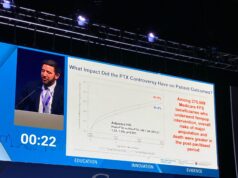A recent US-wide, multicentre analysis has found no evidence of increased all-cause mortality associated with the use of paclitaxel-coated devices compared with non-drug-coated devices for femoropopliteal artery revascularisation. The study, published in JAMA Cardiology, sought to evaluate differences in all-cause mortality between patients treated with and without drug-coated devices for femoropopliteal artery revascularisation. It follows the Katsanos meta-analysis published late last year that reported a higher incidence of death in the long-term with paclitaxel device use in the leg. The study investigators do acknowledge limitations of the present study, recognising that the median follow-up of 389 days was several years shy of the five years’ follow-up included in the Katsanos meta-analysis, and admit that “it is possible that the risks of drug-coated devices could become apparent over greater follow-up.” In a subsequent commentary, Jay Giri suggests some “key principles” for monitoring post-marketing safety of endovascular devices, to allow for “more informed decision making by patients and physicians”.
This retrospective cohort study evaluated 16,650 patients, who were Centres for Medicare and Medicaid beneficiaries, admitted for femoropopliteal artery revascularisation in 2016. It found that the cumulative incidence of all-cause mortality was lower among those who were treated with drug-coated devices when compared to those treated with non-drug-coated devices through 600 days’ follow-up post-procedure (32.5% vs. 34.2%, respectively; p=0.007).
The study investigators, Eric Secemsky (Boston, USA) and colleagues, surmise: “Among Centers for Medicare and Medicaid services patients, we found no signal for increased all-cause mortality following femoropopliteal artery revascularisation with drug-coated devices.” However, the study authors call for a patient-level meta-analysis of randomised clinical trials with survival methods to confirm their conclusions.
Going into more detail on their results, Secemsky et al explain: “When stratified by the type of device used for revascularisation, similar survival trends were observed for patients who were treated with drug-coated balloon (DCB) angioplasty (p=0.06), and drug-eluting stent (DES) vs. bare metal stent (BMS; p=0.56).” In addition to device type, the study investigators also analysed whether their conclusion held when adjusted for patient, procedure, and hospital characteristics. Their findings were consistent in all cases.
This trend was also observed in patients in a more severe condition; among patients with critical limb ischaemia (CLI), there was a lower mortality rate of 38.1% in the group treated with drug-coated devices, compared to 40.1% for those treated without drug-coated devices (p=0.04). The authors note that patients with CLI represented a minority of patients included in the Katsanos et al meta-analysis.
In response to the Katsanos meta-analysis findings
Citing the recent Katsanos meta-analysis published in JAHA, Secemsky and colleagues enumerate “limitations that mitigate its implication”, notably the use of summary-level data. Following the meta-analysis publication, there has been a swell of papers from industry based on individual-level data concluding that there is no association between increased mortality and paclitaxel treatments.
The Katsanos et al meta-analysis found that all-cause mortality rates at two and five years were greater among patients treated with paclitaxel devices, though gave no mechanism of death. Potential candidates suggested by the authors are increased risks of infection, pulmonary disease, and malignancy. These results raised enough concern within the community to halt two ongoing clinical trials, SWEDEPAD and BASIL III, and for the US FDA to initiate an urgent internal safety review with all companies that produce drug delivery technologies for femoropopliteal disease.
However, Secemsky and colleagues add that, in Katsanos’ study, “Mortality rates were estimated using the trial enrolment population, which fails to account for patient withdrawal and loss to follow-up.” Due to the lack of patient-level data in the meta-analysis, Secemsky also notes that summary-level trial data “cannot account for missing data at the individual level, and may lack up-to-date follow-up information. As such”, he continues, “the significance of this harm signal requires replication in other populations to substantiate or alleviate the perceived safety risk.”
Further, as the present study was observational, the treatment effect was non-randomised, meaning the authors “cannot account for treatment selection bias by operators or residual unmeasured confounding.”
Patient characteristics
In this present study, of the 16,560 patients who underwent femoropopliteal artery revascularisation at the 1,883 hospitals under scrutiny, DCB use alone accounted for 16.4% of the treatments (2,709 patients). Percutaneous transluminal angioplasty (PTA) was used as the only treatment in 35% of patients (5,796); DES with DCB in 5.1% (851 patients); BMS with DCB was used in 4.4% of cases (727 patients); DES alone was used in 10.3% of cases (1,702 patients); and just a BMS was used in 28.8% of cases (4,775 patients).
The mean patient age was 72.9 years, and the total population cohort was 46.7% men, 73.9% white, and 49.7% current or previous smokers. Additionally, 59.3% had diabetes, and 51% had CLI—two conditions understood to complicate treatment.
There were no significant differences at baseline between the two arms of the study: those treated with drug-coated devices, and those treated without drug-coated devices. However, patients who were treated with drug-coated devices were more often men, and had a higher prevalence of congestive heart failure, diabetes, hypothyroidism, and anaemia, the authors write.
However, Secemsky and colleagues note that as their analysis was based on Medicare fee-for-service beneficiaries, the population was older and had a higher rate of comorbidities, such as CLI, than in the cohort under scrutiny in the Katsanos et al meta-analysis. They write: “The higher rates of mortality observed in our study likely reflect these differences in patient characteristics. As our analysis could not differentiate cause-specific mortality, we were unable to account for the competing risk of death between cardiovascular and non-cardiovascular causes, or evaluate for associations between drug exposure and specific causes of death.”
Comment: Key principles of a “modern approach” to monitoring post-marketing safety
In a commentary on the results of this study, Jay Giri remarks that there is “insufficient evidence to place a blanket moratorium on the use of PEB/PES out of concerns for long-term safety.” However, he adds that “a careful risk-benefit discussion with patients about the uncertainty in long-term outcomes with these devices is warranted in the context of their greater efficacy with regard to revascularisation outcomes.”
Giri suggests that a “modern approach to monitoring post-marketing safety of endovascular devices might be guided by the following key principles: [1] using administrative data sets for predefined raw looks at device performance [the study by Secemsky et al fits into this category]; [2] mandating public availability of individual patient data for all trials that are cited to support either the European Conformité Européene mark or US Food and Drug clearance or approval; and [3] facilitating linkage of disease and device-specific registries to a broad array of administrative data that will allow for inexpensive, long-term patients follow-up for major adverse events.”
He concludes that “the promise of the modern era of data science is predicated on making this data available to trained researchers in forms that can be used to allow for more informed decision making by patients and physicians, while providing more certainty for device manufacturers.”













